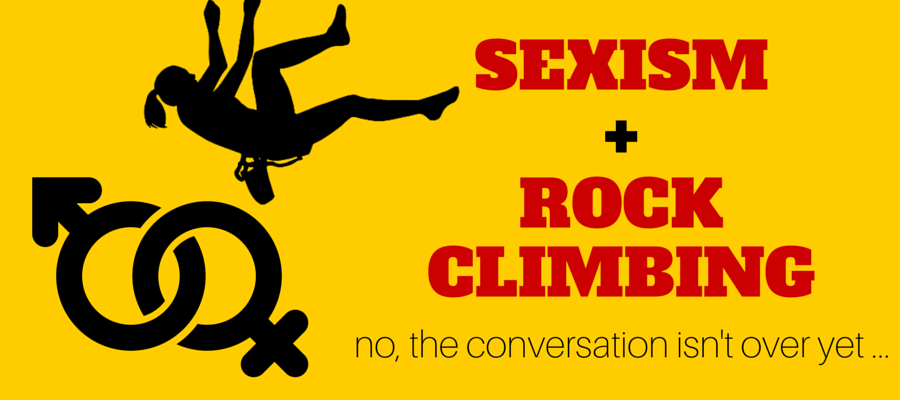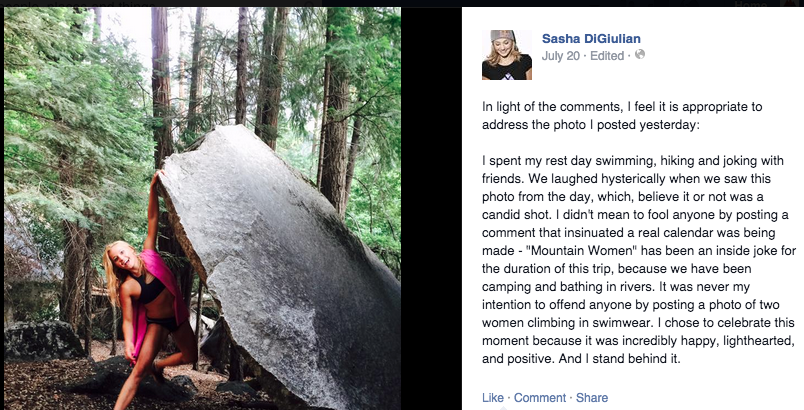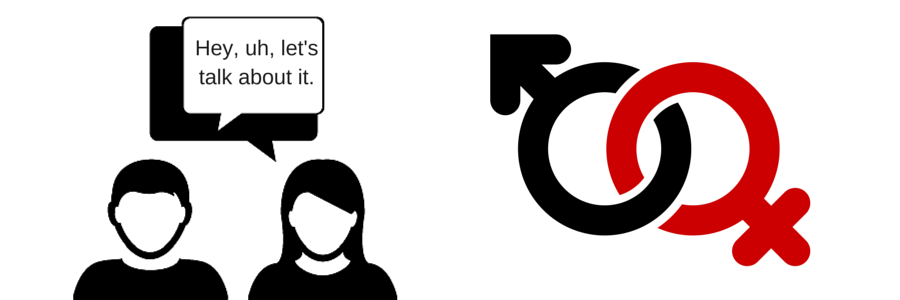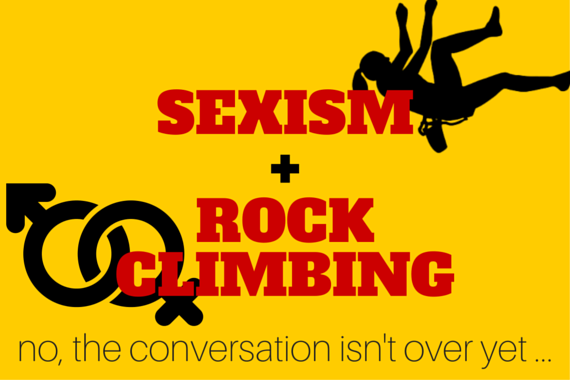
In no way do the thoughts or ideas expressed in this article reflect the opinions of Moja Gear. We do, however, support a platform for freedom of expression and open discussion within the climbing community.
Hey wait, hold on! Are you still reading?
Or did that simple phrase, “sexism and rock climbing,” make you gag a little? Are you about to throw your laptop against the wall? Are you already rolling your eyes? Are you totally sick of hearing about this subject? I don’t blame you, but hear me out. This is important.
There has been quite a buzz in our rapidly growing community about sexism in climbing media. Some people think that climbing media is sexist, and others think it isn’t.
So—is it, or isn’t it?
This is what I think.
You still with me? Okay.
The existence of sexism in climbing
Although when we go climbing it may feel as if we’re in Neverland and that no evil can touch us, our beloved community is not immune to the issues that plague all of society—sexism included. I know, it sucks. It’s uncomfortable, it’s messy, and no one wants to talk about it, but we have to.
There are some blatant instances of sexism in climbing media, like when an athlete is described by their appearance instead of their accomplishments. In one example among many, the title of Hazel Findlay’s Enormocast episode is “Being Blonde, Bold, and Resolute.” Most of us can agree that including the color of her hair in the title of the episode is in fact sexist. It insinuates that “being blonde” is more important than her accomplishments as an athlete.
Could you imagine if Adam Ondra was introduced or described as “Being a Curly Headed Brunette?” It would just be weird …

Photo: Mateusz Koskot
So is climbing media sexist or not?
However, some climbing media that has been deemed sexist is actually not. This happens more commonly in the realm of climbing films and photos when a female athlete is the subject. The female body is an inherently sexual thing, so photos of women rock climbing may appear over-sexualized, when in fact we’re just looking at a picture of a woman climbing a rock.
Sasha DiGiulian was accused of perpetuating sexism in climbing media and “selling” her body because of this picture on her Instagram account. While I don’t entirely understand what’s going on in this photo, I don’t believe that this is overly sexual. I especially don’t think that Sasha was deserving of the negative comments she received.
Related: An Interview with Sasha DiGiulian
But how do we know for sure if an image is contributing to sexism and when it is not? This is a terribly hard question to answer because of the highly complex nature of sexism, our uncomfortableness with the subject, and the unavoidable social conditioning that has influenced us all to some extent. But, in my opinion, we have to try.
I believe that the answer to that question lies within the authenticity of the media. Does the image represent real life? Have you seen this situation actually occur while rock climbing? Can you see yourself in the photo? Can you relate to what’s going on?
Or, in simplest terms: Is this image real?
In Sasha’s case, the scene depicted by her photo actually happens in real life. Sometimes you go swimming and climb around on boulders afterwards. To ask Sasha to cover up or not depict herself wearing a bathing suit is shaming of the female body, sexist, and not okay.

But what if the media in question is not real?
What if it represents something that doesn’t happen in climbing? Then perhaps it is contributing to sexism and objectification. And yes, if your gut is telling you that maybe it’s not that simple, you’re probably right.
That’s where you come in, with your own opinions and judgements. You have to make the call.
In my opinion, I find it very hard to relate to an image of a woman climbing with freshly shampooed hair and a full face of makeup. I have never gone climbing like that, and I don’t think I’ve ever seen another woman climbing like that. So to me, images like that seem sexist.
But regardless of the conclusions that you come to about the image—sexist or not sexist—shaming the woman in the photo is never okay. In fact, it’s sexist. This alone is the most important message that we take away from this issue.
The hard truth about sexism in climbing
I’ve learned this the hard way. I’ve been very vocal about my disappointment with the way females are represented in climbing media, and at times I have expressed this in a negative manner.
A few weeks ago, I publicly accused (via Facebook) a female climber of perpetuating sexism in our sport. I did not save what I wrote, but I can tell you that while my wording was actually pretty respectful, it was still wrong of me to write. Although I deleted the post within a half hour, there were already over 50 comments made, most of which were in agreement with my opinion. Even weeks later, people are still sending me messages and asking me about it in person.
All I knew for sure was that what I wrote didn’t feel right, that I had hit a sore spot in our sport, and that we very badly needed to address this issue as a community. This article is my attempt at doing that.

Sexism exists in climbing media just like it does in every corner of our society. We cannot battle the issue by shaming the athlete in the photo, blog post, film, or interview. The individual has every right to depict themselves in whatever way they choose. However, these are athletes that we’re talking about, and athletes represent brands.
So here is what you can do: if you do see media that you find sexist, contact the companies that sponsor the athlete and tell them how you feel. And perhaps make the choice to not buy their products.
Other than that, the only thing we can do about this issue is to speak of it, and to speak of it often. Because no matter how much we want to ignore it, it’s not going away.
Want more climbing content? Get our awesome climbing newsletter, delivered weekly.
Explore more
- Dude Grades: A Look at Sexism in Climbing Grades
- Looking for a Partner, Pants Off Limits
- Being Strong and Fragile: A Discussion on Sexism, Racism, Exclusivity, and Privilege in Climbing
- The Climb-a-Sutra: More Than Just a Sexy Book (NSFW)
- A Recap of the 2016 Flash Foxy Women’s Climbing Festival and What It Means for Female Climbers
- Top 25 Books for Rock Climbers
- Our 30+ most popular articles ever
- In Defense of Spray








